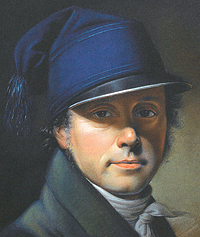Christian Horneman (painter)
Christian Horneman (born August 15, 1765 in Copenhagen , † March 7, 1844 ibid) was a Danish painter who was mainly known for his miniature portraits . He was the father of the composer Emil Horneman (1809-1870) and the grandfather of the composer Christian Horneman .
Life
Horneman attended the Royal Danish Academy of Fine Arts from 1780 and went abroad in 1787 to continue his studies. In 1789 he saw the outbreak of the French Revolution in Paris and also visited Italy . He later lived in Berlin for a long time , where he met King Friedrich Wilhelm III. and portrayed Queen Luise . The works were engraved by Meno Haas and thus gained wider circulation. In Berlin he studied in particular with Daniel Chodowiecki . With a letter of recommendation from the sculptor Gottfried Schadow to Heinrich Friedrich Füger , he finally came to Vienna in 1798 , where he studied with Füger. He also stayed temporarily in Weimar, where he made a silver pencil drawing of the famous actress Caroline Jagemann in 1800 . Together with their son, the painter Ferdinand Jagemann (1780–1820), he arrived in Salzburg by ship on July 24, 1801, only to move back to Vienna for a longer period of time.
Horneman returned to Denmark in 1803 and was appointed royal court miniaturist the following year. In 1805 he became a member of the art academy and in 1816 received a free residence in Charlottenborg Palace , the seat of the academy. 1835 was appointed professor .
In his later years he suffered from poor health and received an annual pension from 1840. He is buried in the garrison cemetery in Copenhagen.
plant
In Vienna he met several important personalities, including Ludwig van Beethoven (1802) and Joseph Haydn , while he was sketching portraits of other people in a sketchbook that is now in the Danish National Gallery . He painted the impressive Beethoven portrait as a miniature on ivory in 1802. Beethoven was very pleased with the result and sent it to his childhood friend Stephan von Breuning at the beginning of November 1804 .
After his return to Denmark he was one of several portrait painters who filled the void after the deaths of Cornelius Høyer and Jens Juel . He made miniatures and especially pastels , which was the technique with which he did his best work. In the 1820s he also turned to lithography .
literature
- Theodor von Frimmel , Beethoven-Handbuch , Leipzig: Breitkopf & Härtel 1926, Volume 1, p. 222f. ( Digitized version )
Web links
Individual evidence
- ^ Ferdinand Laban , Heinrich Friedrich Füger, the portrait miniaturist , Berlin 1905, p. 25
- ↑ Today in the Goethe Museum Düsseldorf
- ^ Intelligence Gazette from Salzburg , No. 31, August 1, 1801, column 470 ( digitized version )
- ↑ Illustration on the Beethoven-Haus website
- ^ Ludwig van Beethoven, Correspondence. Complete edition , Volume 1, ed. by Sieghard Brandenburg , Munich 1996, p. 227
| personal data | |
|---|---|
| SURNAME | Horneman, Christian |
| BRIEF DESCRIPTION | Danish painter |
| DATE OF BIRTH | August 15, 1765 |
| PLACE OF BIRTH | Copenhagen |
| DATE OF DEATH | March 7, 1844 |
| Place of death | Copenhagen |


